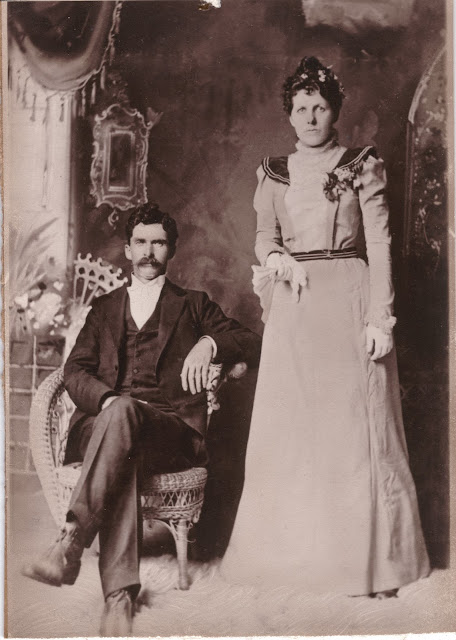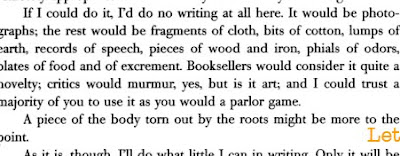Found
A well-swept yard was once the mark of a well-kept house and property, owned or lent
Showing posts with label photograph. Show all posts
Showing posts with label photograph. Show all posts
Saturday, February 10, 2018
Friday, August 11, 2017
My Grandparents Allen, Wedding Day
This photograph dates to 1899 and shows my Grandfather and Grandmother Allen (Julius Henry Allen, Lillian Eremine McKinley) on their wedding day. Showing front and back of the card photograph. The notes were made by Lucille Allen
Back of photograph. No month/day has been determined for their 1899 marriage.
This was the second marriage for Julius. His first wife, Josephine Farmer (also known as Mary Josephine and Josie) died 11 May 1897.
Back of photograph. No month/day has been determined for their 1899 marriage.
This was the second marriage for Julius. His first wife, Josephine Farmer (also known as Mary Josephine and Josie) died 11 May 1897.
Monday, November 26, 2012
Wondering why photographs of people are so precious
I graduated from Hopkins
with a Ph.D. in Byzantine art and architecture and then turned my research
efforts to the history of photography. On the face of it, that is a radical
career jump. But Byzantium, in particular the Byzantine icon and the justifications
for the icon intrigued me. The proper (working) icon had to bear a resemblance
to the saint represented and had to be made "in the right way." Then
there was a special kind of icon that was not made by human hands
(acheiropoieta), images that miraculously appeared (the earliest example may
have been the Veil of Veronica, an imprint of the face of Jesus left when
Veronica used her veil to blot away the sweat on the face during the march to
Golgatha). The icon, a representation rather than an idol, seemed to enjoy a
special identity with the person represented.
I wondered if any
post-Byzantine European civilization shared a belief in this very powerful kind
of image and one day it hit me that the general attitude was not so different
from popular attitudes toward photographs. A photograph's resemblance to the
subject is pretty obvious. Being made in the right way is understandable to
each of us who had a roll of film returned with negatives that were so bad that
the processor claimed that nothing could be printed (for the younger, this
refers to ancient picture-making process that involved something called film).
It was the identity characteristic that seemed most telling to me. We treat
certain photographic images (especially portraits) as treasured objects
precisely because they bear such a resemblance to a person.
Were I to take from you
a portrait of someone dear to you and rip it apart, you would react with
sadness and fury. Remember, it is nothing more than a piece of paper with tones
covering it. But what I have I really done in your eyes? I have destroyed a
precious object that was precious precisely because it bore a resemblance of
somebody important to you. On the other hand, I have seen people tear apart a
photograph when they experience deep anger towards the person "in"
the photograph. (This seems to happen most often when a relationship goes
sour).
I pick up snapshots at
flea markets. I have no idea where the snapshots were made or who they
represent. Finding a snapshot that has been torn to remove a figure that
originally stood next to the figure that was kept, is an assault on history.
For whatever reason, the removed figure should never have been standing next to
the preserved figure (and by the way, we have some examples of the delicate
surface of daguerreotypes having been rubbed to effect the same purpose).
While only in spiritualists circles do images seem to appear magically, the notion that photographs are the result of a mechanical process, an image that is not the work of a person but of a machine, was the basis of a very long prejudice against the idea that photographs could be works of art. The maker of a photograph knows how to make the camera work and has little control over how the picture looks (a common attitude no matter how naïve).
The analogy has
not escaped some religious writing
Icons Unite: photographs, films, videos of people we love can make them seem very close. The icons can make us feel very close to Christ and the saints - and this feeling of closeness is no illusion....
The analogy between the photograph and the icon allowed me to see how a believer in the identity between an image and the thing represented embodies attitudes that can easily be seen as expressions of faith, the one clearly a religious belief and the other a fuzzy material faith or belief.
I was able to
look again at the Byzantine icon with a heightened awareness of just how
precious pictures can be.
Friday, May 6, 2011
While thinking of the Osama photographs
Photographs reveal more than the subject. A photograph always speaks of the intention of the maker or the intention of the subject cooperating with the maker. Alexander Gardner’s Civil War “What Do I Want, John Henry?” speaks volumes on the social attitudes within the Army of Liberation . The decision of Roy Stryker to widely release only one image of the Dorothea Lange Migrant Mother series tells us about a sway from reportage to poignancy. The several views of Che talk to us about the cooperation of the photographer in establishing the fame of the hunters (everybody gets his chance).
So, I do not want so much to see the Osama bin Laden death photographs as I would like to see them and think about what they mean, to see if I recognize an emotion or an illusion. Or maybe myself.
But I am also content to wait for the release. After all, that will not be long. I can see them in the grocery store checkout next week.
So, I do not want so much to see the Osama bin Laden death photographs as I would like to see them and think about what they mean, to see if I recognize an emotion or an illusion. Or maybe myself.
But I am also content to wait for the release. After all, that will not be long. I can see them in the grocery store checkout next week.
Monday, January 24, 2011
Subscribe to:
Comments (Atom)
Dowdles
My Dowdle Family Photograph Document photographs, as distinct from documentary photographs, can be frustrating. Once subject and other inf...

-
Written by W. T. Daffron, my grandfather, of Millport Alabama, probably in 1932. It was the height of the Great Depression. The Hays...
-
My Dowdle Family Photograph Document photographs, as distinct from documentary photographs, can be frustrating. Once subject and other inf...
-
William Julius Allen, who as a man such advanced years that he might as well call himself an old man, says: My grandfather Will was fascinat...





